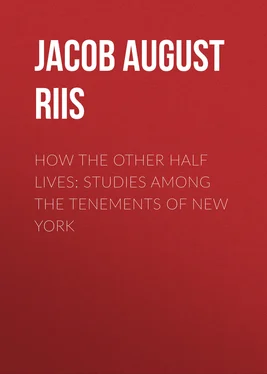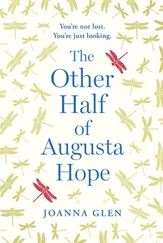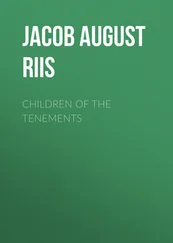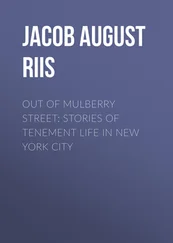Jacob August Riis - How the Other Half Lives - Studies Among the Tenements of New York
Здесь есть возможность читать онлайн «Jacob August Riis - How the Other Half Lives - Studies Among the Tenements of New York» — ознакомительный отрывок электронной книги совершенно бесплатно, а после прочтения отрывка купить полную версию. В некоторых случаях можно слушать аудио, скачать через торрент в формате fb2 и присутствует краткое содержание. Жанр: foreign_prose, sociology_book, foreign_antique, на английском языке. Описание произведения, (предисловие) а так же отзывы посетителей доступны на портале библиотеки ЛибКат.
- Название:How the Other Half Lives: Studies Among the Tenements of New York
- Автор:
- Жанр:
- Год:неизвестен
- ISBN:нет данных
- Рейтинг книги:3 / 5. Голосов: 1
-
Избранное:Добавить в избранное
- Отзывы:
-
Ваша оценка:
- 60
- 1
- 2
- 3
- 4
- 5
How the Other Half Lives: Studies Among the Tenements of New York: краткое содержание, описание и аннотация
Предлагаем к чтению аннотацию, описание, краткое содержание или предисловие (зависит от того, что написал сам автор книги «How the Other Half Lives: Studies Among the Tenements of New York»). Если вы не нашли необходимую информацию о книге — напишите в комментариях, мы постараемся отыскать её.
How the Other Half Lives: Studies Among the Tenements of New York — читать онлайн ознакомительный отрывок
Ниже представлен текст книги, разбитый по страницам. Система сохранения места последней прочитанной страницы, позволяет с удобством читать онлайн бесплатно книгу «How the Other Half Lives: Studies Among the Tenements of New York», без необходимости каждый раз заново искать на чём Вы остановились. Поставьте закладку, и сможете в любой момент перейти на страницу, на которой закончили чтение.
Интервал:
Закладка:
The “Rock of Ages” is the name over the door of a low saloon that blocks the entrance to another alley, if possible more forlorn and dreary than the rest, as we pass out of the Alderman’s court. It sounds like a jeer from the days, happily past, when the “wickedest man in New York” lived around the corner a little way and boasted of his title. One cannot take many steps in Cherry Street without encountering some relic of past or present prominence in the ways of crime, scarce one that does not turn up specimen bricks of the coming thief. The Cherry Street tough is all-pervading. Ask Superintendent Murray, who, as captain of the Oak Street squad, in seven months secured convictions for theft, robbery, and murder aggregating no less than five hundred and thirty years of penal servitude, and he will tell you his opinion that the Fourth Ward, even in the last twenty years, has turned out more criminals than all the rest of the city together.
But though the “Swamp Angels” have gone to their reward, their successors carry on business at the old stand as successfully, if not as boldly. There goes one who was once a shining light in thiefdom. He has reformed since, they say. The policeman on the corner, who is addicted to a professional unbelief in reform of any kind, will tell you that while on the Island once he sailed away on a shutter, paddling along until he was picked up in Hell Gate by a schooner’s crew, whom he persuaded that he was a fanatic performing some sort of religious penance by his singular expedition. Over yonder, Tweed, the arch-thief, worked in a brush-shop and earned an honest living before he took to politics. As we stroll from one narrow street to another the odd contrast between the low, old-looking houses in front and the towering tenements in the back yards grows even more striking, perhaps because we expect and are looking for it. Nobody who was not would suspect the presence of the rear houses, though they have been there long enough. Here is one seven stories high behind one with only three floors. Take a look into this Roosevelt Street alley; just about one step wide, with a five-story house on one side that gets its light and air—God help us for pitiful mockery!—from this slit between brick walls. There are no windows in the wall on the other side; it is perfectly blank. The fire-escapes of the long tenement fairly touch it; but the rays of the sun, rising, setting, or at high noon, never do. It never shone into the alley from the day the devil planned and man built it. There was once an English doctor who experimented with the sunlight in the soldiers’ barracks, and found that on the side that was shut off altogether from the sun the mortality was one hundred per cent. greater than on the light side, where its rays had free access. But then soldiers are of some account, have a fixed value, if not a very high one. The people who live here have not. The horse that pulls the dirt-cart one of these laborers loads and unloads is of ever so much more account to the employer of his labor than he and all that belongs to him. Ask the owner; he will not attempt to deny it, if the horse is worth anything. The man too knows it. It is the one thought that occasionally troubles the owner of the horse in the enjoyment of his prosperity, built of and upon the successful assertion of the truth that all men are created equal.
With what a shock did the story of yonder Madison Street alley come home to New Yorkers one morning, eight or ten years ago, when a fire that broke out after the men had gone to their work swept up those narrow stairs and burned up women and children to the number of a full half score. There were fire-escapes, yes! but so placed that they could not be reached. The firemen had to look twice before they could find the opening that passes for a thoroughfare; a stout man would never venture in. Some wonderfully heroic rescues were made at that fire by people living in the adjoining tenements. Danger and trouble—of the imminent kind, not the everyday sort that excites neither interest nor commiseration—run even this common clay into heroic moulds on occasion; occasions that help us to remember that the gap that separates the man with the patched coat from his wealthy neighbor is, after all, perhaps but a tenement. Yet, what a gap! and of whose making? Here, as we stroll along Madison Street, workmen are busy putting the finishing touches to the brown-stone front of a tall new tenement. This one will probably be called an apartment house. They are carving satyrs’ heads in the stone, with a crowd of gaping youngsters looking on in admiring wonder. Next door are two other tenements, likewise with brown-stone fronts, fair to look at. The youngest of the children in the group is not too young to remember how their army of tenants was turned out by the health officers because the houses had been condemned as unfit for human beings to live in. The owner was a wealthy builder who “stood high in the community.” Is it only in our fancy that the sardonic leer on the stone faces seems to list that way? Or is it an introspective grin? We will not ask if the new house belongs to the same builder. He too may have reformed.
We have crossed the boundary of the Seventh Ward. Penitentiary Row, suggestive name for a block of Cherry Street tenements, is behind us. Within recent days it has become peopled wholly with Hebrews, the overflow from Jewtown adjoining, pedlars and tailors, all of them. It is odd to read this legend from other days over the door: “No pedlars allowed in this house.” These thrifty people are not only crowding into the tenements of this once exclusive district—they are buying them. The Jew runs to real estate as soon as he can save up enough for a deposit to clinch the bargain. As fast as the old houses are torn down, towering structures go up in their place, and Hebrews are found to be the builders. Here is a whole alley nicknamed after the intruder, Jews’ Alley. But abuse and ridicule are not weapons to fight the Israelite with. He pockets them quietly with the rent and bides his time. He knows from experience, both sweet and bitter, that all things come to those who wait, including the houses and lands of their persecutors.
Here comes a pleasure party, as gay as any on the avenue, though the carry-all is an ash-cart. The father is the driver and he has taken his brown-legged boy for a ride. How proud and happy they both look up there on their perch! The queer old building they have halted in front of is “The Ship,” famous for fifty years as a ramshackle tenement filled with the oddest crowd. No one knows why it is called “The Ship,” though there is a tradition that once the river came clear up here to Hamilton Street, and boats were moored along-side it. More likely it is because it is as bewildering inside as a crazy old ship, with its ups and downs of ladders parading as stairs, and its unexpected pitfalls. But Hamilton Street, like Water Street, is not what it was. The missions drove from the latter the worst of its dives. A sailors’ mission has lately made its appearance in Hamilton Street, but there are no dives there, nothing worse than the ubiquitous saloon and tough tenements.
Enough of them everywhere. Suppose we look into one? No. – Cherry Street. Be a little careful, please! The hall is dark and you might stumble over the children pitching pennies back there. Not that it would hurt them; kicks and cuffs are their daily diet. They have little else. Here where the hall turns and dives into utter darkness is a step, and another, another. A flight of stairs. You can feel your way, if you cannot see it. Close? Yes! What would you have? All the fresh air that ever enters these stairs comes from the hall-door that is forever slamming, and from the windows of dark bedrooms that in turn receive from the stairs their sole supply of the elements God meant to be free, but man deals out with such niggardly hand. That was a woman filling her pail by the hydrant you just bumped against. The sinks are in the hallway, that all the tenants may have access—and all be poisoned alike by their summer stenches. Hear the pump squeak! It is the lullaby of tenement-house babes. In summer, when a thousand thirsty throats pant for a cooling drink in this block, it is worked in vain. But the saloon, whose open door you passed in the hall, is always there. The smell of it has followed you up. Here is a door. Listen! That short hacking cough, that tiny, helpless wail—what do they mean? They mean that the soiled bow of white you saw on the door downstairs will have another story to tell—Oh! a sadly familiar story—before the day is at an end. The child is dying with measles. With half a chance it might have lived; but it had none. That dark bedroom killed it.
Читать дальшеИнтервал:
Закладка:
Похожие книги на «How the Other Half Lives: Studies Among the Tenements of New York»
Представляем Вашему вниманию похожие книги на «How the Other Half Lives: Studies Among the Tenements of New York» списком для выбора. Мы отобрали схожую по названию и смыслу литературу в надежде предоставить читателям больше вариантов отыскать новые, интересные, ещё непрочитанные произведения.
Обсуждение, отзывы о книге «How the Other Half Lives: Studies Among the Tenements of New York» и просто собственные мнения читателей. Оставьте ваши комментарии, напишите, что Вы думаете о произведении, его смысле или главных героях. Укажите что конкретно понравилось, а что нет, и почему Вы так считаете.












